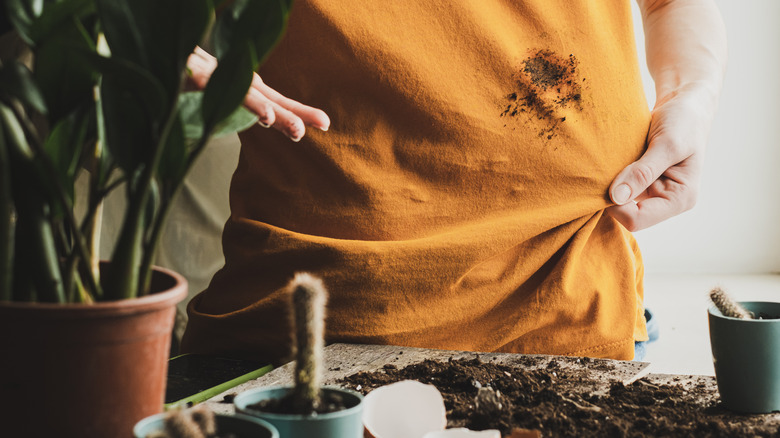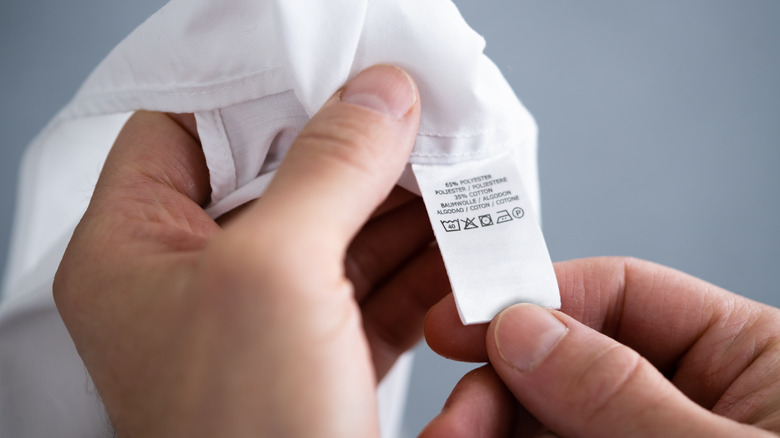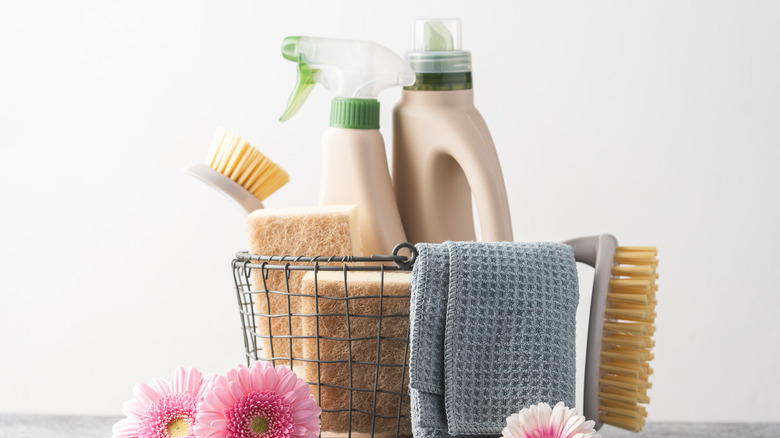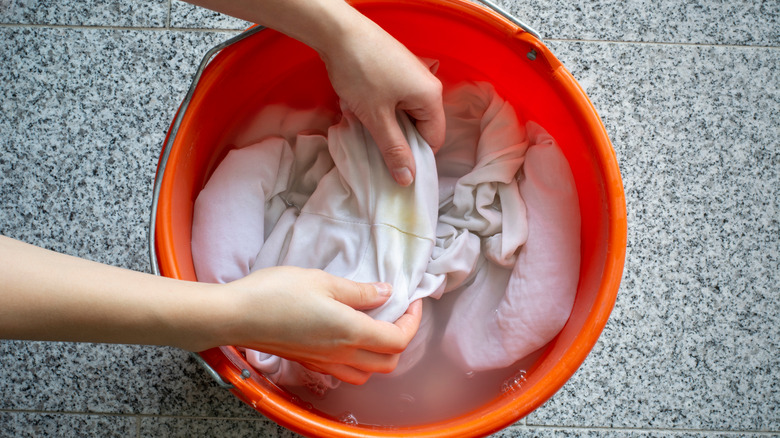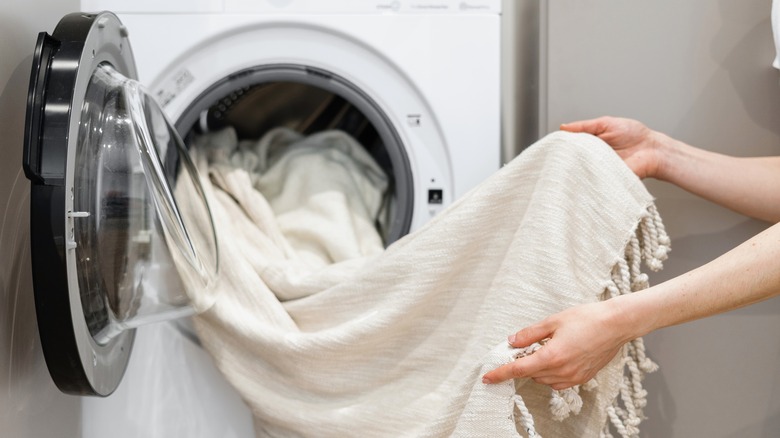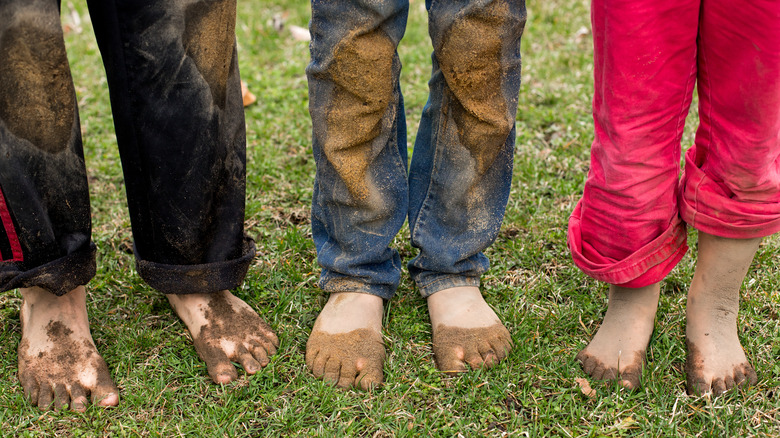The Best Way To Remove Mud Stains From Clothes
The weather really does dictate how many stains you get on your clothing. It doesn't care for your expensive shoes or new linen floral pants, and it sure doesn't think twice about your designer trench coat. Late winter going into spring is not the best time for apparel in general. Think ice breaking up and slushy mud covering the roads you normally take to work. You can be as careful as you like stepping over the watery mess, but you're bound to come back home with mud stains.
Even if you successfully avoid getting dirt on you while commuting to and back from work, what about the time you wanted to experience something new in the form of a skincare routine? You thought you'd read up on everything you need to know before trying a mud treatment, but unfortunately you came back home with sludge on your precious white T-shirt. Plus, if you have children or pets in your household, staying away from mud stains can seem like a Herculean feat.
Seeing an angry splotch of mud on your favorite piece of clothing can be disheartening. You may be tempted to throw the still-wet fabric in the washer and get it clean as soon as possible, but there's more to removing mud stains than you might think. Here are some things to consider.
Think about the material and read the label
You might assume that the label on your clothing is only good for checking for size at the store, but a lot more can be gleaned from it. For starters, it'll tell you about the fabric and how it's supposed to be handled during cleaning. There is such a thing as the right way to wash silk at home, and getting mud stains off spandex might not be as tough as getting them out of a cotton dress. Leather and fur coats have specific instructions too.
The label will also give you an indication of what kind of washing liquid is safe to use and if the clothing needs to be dry-cleaned or not. Attempting to wash off mud stains from clothes that need to be handled by a professional dry cleaner is probably a bad idea.
We get it: After a tiring day outdoors, the last thing you want to think about is doing a load of laundry when you get back home. You might be tempted to throw the mud-stained clothes in the bin to worry about at the end of the week. But mud has a way of becoming worse with time, so it's best to tackle the problem sooner rather than later.
What you'll need and how to get started
First, you need a plastic knife or spoon, a hand vacuum, liquid laundry detergent, dishwashing liquid, warm water, a soft-bristled toothbrush, a washing machine, and bleach or stain remover (if the material can handle it).
Begin by letting your soiled garment dry fully. Attempting to remove a mud stain from moist clothes will only make things worse — you run the risk of spreading the stain and pushing it deeper into the fabric. Afterward, try and find a countertop that's easily accessible, which will make things easier. Lay out your clothing on the counter and assess the damage. The length of the cleaning process will vary depending on the extent of the stain, but be prepared for at least two rounds. Now, as Simran Gandhi of Glamrs by Purplle says, separate the two ends of your garment with a book or magazine so that the stain doesn't seep onto the other side when you're working on it.
Next, using the plastic spoon or knife, gently scrape off the dried-up dirt. Afterward, you can either dust the loose dirt off or vacuum the remnants.
Now come the solvents
Dishwashing liquid contains an additional kick that's better at removing oil-infused mud stains than normal laundry detergent, according to Dan Miller, founder of Mulberrys Garment Carer. So if your stain was the result of road splash reaching your pants, dishwashing liquid might be the way to go. Additionally, you can choose between soaking the entire piece of clothing in warm water and solvent or adding a bit of cleaning product to the spot (or spots) — depending on how extensive the stain is.
If you're treating just a few spots, squirt some solvent onto the stain and leave it to rest for 15 minutes. Using a soft-bristled brush dipped in warm water, gently scrub at the soiled area. If you're uncomfortable with the toothbrush concept, gently rub the clothing between your fingers.
According to Miller, movement (rubbing material together) is an essential part of the cleaning process.
Final steps: You're almost done
At this point, you can rinse off the stained portion of the clothing, and for especially stubborn spots, you can rinse in rubbing alcohol. However, rubbing alcohol usually contains dyes of its own in addition to isopropyl alcohol, so be aware that this could cause more stains. If you see more staining after rinsing, add a few more squirts of detergent and let it rest for a few minutes before scrubbing further.
From here, you can try a stain remover to help remove any residual mud. Just make sure you let the product rest on the stain for at least five minutes before you go in. Bleach is an option too, but there are different kinds of bleach that work better with different fabrics. For example, sodium hypochlorite is best for most whites and colorfast clothes, while the gentler oxygen bleach can be used on almost any washable material. Also, the clothing label will tell you if bleach is safe for the fabric or not.
Next, rinse the garment in warm water using your hands or a washing machine. Don't be disappointed if you still see traces of the stain once your clothes come out of the washer. Simply repeat the recommended steps a few times over until the stain is completely gone. But be sure to do so before you dry your clothing — throwing stained clothes in the dryer will only make the dirt set in more firmly.
Recommended products
Sure, you may want to hide your piece of clothing deep in your wardrobe and never put it through this ordeal ever again, or tell your kids to never play outside ever again. But as long as you have the right products and act on time, there is no need to keep your clothes hidden or your children under house arrest.
The Vanish Oxi Action Stain Remover Powder is a great product to have at home for times like these. It's best used in combination with the last few steps — add a bit of it to your washing machine when you're doing the final rinsing. OxiClean Versatile Stain Remover is another good choice. Remember: The difference between washing your clothes wrong and doing it the right way could lie in the products you choose to use.
At the end of the day, mud stains don't have to be frightening — they will come off if you tackle them using the proper methods.
